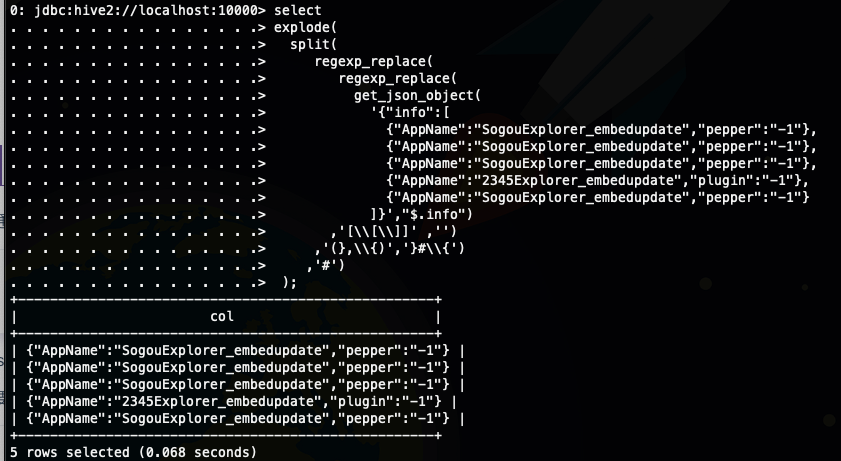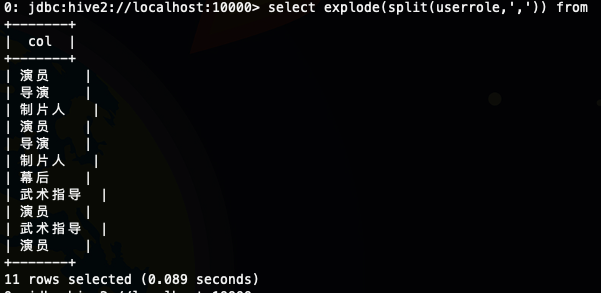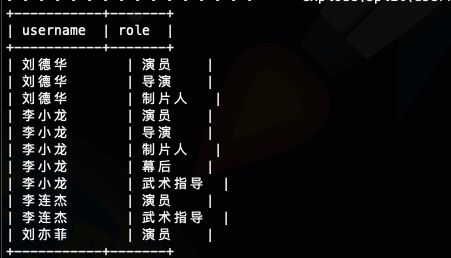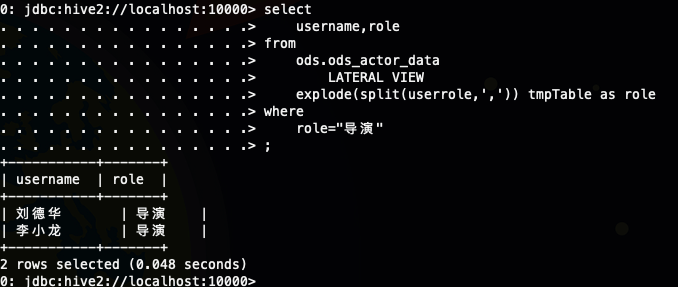本文转载自微信公众号「Java大数据与数据仓库」,作者刘不二。转载本文请联系Java大数据与数据仓库公众号。
explode 和 lateral view
为什么把这两个放一块呢,因为这两个经常放在一起用啊
explode与lateral view在关系型数据库中本身是不该出现的,因为他的出现本身就是在操作不满足第一范式的数据(每个属性都不可再分),本身已经违背了数据库的设计原理(不论是业务系统还是数据仓库系统),不过大数据技术普及后,很多类似pv,uv的数据,在业务系统中是存贮在非关系型数据库中,用json存储的概率比较大,直接导入hive为基础的数仓系统中,就需要经过ETL过程解析这类数据,explode与lateral view在这种场景下大显身手。
explode用法
在介绍如何处理之前,我们先来了解下Hive内置的 explode 函数,官方的解释是:explode() takes in an array (or a map) as an input and outputs the elements of the array (map) as separate rows. UDTFs can be used in the SELECT expression list and as a part of LATERAL VIEW. 意思就是 explode() 接收一个 array 或 map 类型的数据作为输入,然后将 array 或 map 里面的元素按照每行的形式输出。其可以配合 LATERAL VIEW 一起使用。光看文字描述很不直观,咱们来看看几个例子吧。
- hive (default)> select explode(array('A','B','C'));
- OK
- A
- B
- C
- Time taken: 4.188 seconds, Fetched: 3 row(s)
- hive (default)> select explode(map('a', 1, 'b', 2, 'c', 3));
- OK
- key value
- a 1
- b 2
- c 3
explode函数接收一个数组或者map类型的数据,通常需要用split函数生成数组。
explode 配合解析Json 数组
这里有数据:
- {"info":[
- {"AppName":"SogouExplorer_embedupdate","pepper":"-1"},
- {"AppName":"SogouExplorer_embedupdate","pepper":"-1"},
- {"AppName":"SogouExplorer_embedupdate","pepper":"-1"},
- {"AppName":"2345Explorer_embedupdate","plugin":"-1"},
- {"AppName":"SogouExplorer_embedupdate","pepper":"-1"}
- ]}
现在需要将AppName和pepper提取出来,然后按行存放,一行一个,首先我们按照上一节我们学习的Json 处理的函数进行尝试
- select
- get_json_object(
- '{"info":[
- {"AppName":"SogouExplorer_embedupdate","pepper":"-1"},
- {"AppName":"SogouExplorer_embedupdate","pepper":"-1"},
- {"AppName":"SogouExplorer_embedupdate","pepper":"-1"},
- {"AppName":"2345Explorer_embedupdate","plugin":"-1"},
- {"AppName":"SogouExplorer_embedupdate","pepper":"-1"}
- ]}',
- "$.info[*].AppName"
- );
如图
image-20201231111231311
但是我们注意到这里虽然提取出来了但是返回值是一个字符串啊,我为啥知道它是字符串,但是看起来像是一个数组啊,因为我用explode 函数试过了,那接下来怎么处理呢,这个时候就可以需要配合split 处理了,为了方便操作我直接用上么的结果进行操作
- ["SogouExplorer_embedupdate","SogouExplorer_embedupdate","SogouExplorer_embedupdate","2345Explorer_embedupdate","SogouExplorer_embedupdate"]
然我我们尝试处理一下上面这个字符串,首先我们需要split 一下,但是在此之前我们需要将两边的中括号去掉,否则到时候我们的数据会包含这个两个符号的
- select regexp_replace('["SogouExplorer_embedupdate","SogouExplorer_embedupdate","SogouExplorer_embedupdate","2345Explorer_embedupdate","SogouExplorer_embedupdate"]',"[\\[\\]]",'')
然后我们就可以split和explode 的了
- select explode(split(regexp_replace('["SogouExplorer_embedupdate","SogouExplorer_embedupdate","SogouExplorer_embedupdate","2345Explorer_embedupdate","SogouExplorer_embedupdate"]',"[\\[\\]]",''),','));
image-20201231112616809
这里解析json数组,我们本质上还是使用regexp_replace替换掉中括号,然后再使用split函数拆分为数据,给explode去分裂成多行。上面的这种写法有问题吗,功能是可以完成,但是这里只是提出来了AppName 这个字段,还有一个字段没有提取出来呢,要是想把它提取出来,上面的步骤你还得再来一遍才可以,接下来我们尝试引入json_tuple来简化一下我们的操作,我们先将其explode 成多行简单json 字符串,然后再使用json_tuple 进行处理
- select
- explode(
- split(
- regexp_replace(
- regexp_replace(
- get_json_object(
- '{"info":[
- {"AppName":"SogouExplorer_embedupdate","pepper":"-1"},
- {"AppName":"SogouExplorer_embedupdate","pepper":"-1"},
- {"AppName":"SogouExplorer_embedupdate","pepper":"-1"},
- {"AppName":"2345Explorer_embedupdate","plugin":"-1"},
- {"AppName":"SogouExplorer_embedupdate","pepper":"-1"}
- ]}',"$.info")
- ,'[\\[\\]]' ,'')
- ,'(},\\{)','}#\\{')
- ,'#')
- );
这里两次调用了regexp_replace,第一次是为了去掉两边的中括号,第二次是为了将,jons 里面的逗号和分割json 的逗号进行区分,因为我们按照数组内容之间的分隔符进行split ,所以这里可以看做是将数组字符串的分隔符有逗号换成了# 号,然后就按照# split 了
image-20201231122203730
接下来就可以调用json_tuple 函数了
- select
- json_tuple(data,'AppName','pepper')
- from(
- select
- explode(
- split(
- regexp_replace(
- regexp_replace(
- get_json_object(
- '{"info":[
- {"AppName":"SogouExplorer_embedupdate","pepper":"-1"},
- {"AppName":"SogouExplorer_embedupdate","pepper":"-1"},
- {"AppName":"SogouExplorer_embedupdate","pepper":"-1"},
- {"AppName":"2345Explorer_embedupdate","plugin":"-1"},
- {"AppName":"SogouExplorer_embedupdate","pepper":"-1"}
- ]}',"$.info")
- ,'[\\[\\]]' ,'')
- ,'(},\\{)','}#\\{')
- ,'#')
- ) as data
- ) json_table;
如图
image-20201231122505355
这样我们就将我们需要的字段解析出来了
lateral view
开始之前我们先说一下它的用法 LATERAL VIEW udtf(expression) tableAlias AS columnAlias,你可以将lateral view翻译为侧视图
我们有这样的一份样本数据(
- 刘德华 演员,导演,制片人
- 李小龙 演员,导演,制片人,幕后,武术指导
- 李连杰 演员,武术指导
- 刘亦菲 演员
这里我们希望转换成下面这样的格式
- 刘德华 演员
- 刘德华 导演
- 刘德华 制片人
- 李小龙 演员
- 李小龙 导演
- 李小龙 制片人
- 李小龙 幕后
- 李小龙 武术指导
- create table ods.ods_actor_data(
- username string,
- userrole string
- )
- ROW FORMAT DELIMITED FIELDS TERMINATED BY '\t';
- load data local inpath "/Users/liuwenqiang/workspace/hive/lateral.data" overwrite into table ods.ods_actor_data;
如图
image-20201231133130769
从我们前面的学习,我们知道这里应该用explode函数
- select explode(split(userrole,',')) from ods.ods_actor_data;
image-20201231134156444
理论上我们这下只要把username 也选出来就可以了
- select username,explode(split(userrole,',')) from ods.ods_actor_data;
Error: Error while compiling statement: FAILED: SemanticException [Error 10081]: UDTF's are not supported outside the SELECT clause, nor nested in expressions (state=42000,code=10081)
因为explode 是一个UDTF,所以你不能直接和其他字段一起使用,那应该怎么做呢在
- select
- username,role
- from
- ods.ods_actor_data
- LATERAL VIEW
- explode(split(userrole,',')) tmpTable as role
- ;
如图
image-20201231154758339
看起来到这里我们的实现就结束了
lateral view outer
为什么会多了一个 OUTER 关键字呢,其实你也可以猜到了outer join 有点像,就是为了避免explode 函数返回值是null 的时候,影响我们主表的返回,注意是null 而不是空字符串
- select
- username,role
- from
- ods.ods_actor_data
- LATERAL VIEW
- explode(array()) tmpTable as role
- ;
如图
image-20201231160414501
加上outer 关键字之后
- select
- username,role
- from
- ods.ods_actor_data
- LATERAL VIEW outer
- explode(array()) tmpTable as role
- ;
如图
image-20201231160459117
其实一个SQL你可以多次使用lateral view也是可以的,就像下面这样
- SELECT * FROM exampleTable
- LATERAL VIEW explode(col1) myTable1 AS myCol1
- LATERAL VIEW explode(myCol1) myTable2 AS myCol2;
lateral view 的实现原理是什么
首先我们知道explode()是一个UDTF 就是一个输入进去,多个输出出来,或者是进去一行,出来一列(多行)
image-20201231162007648
lateral view 关键字就是将每一行的特定字段交给explode 函数的表达式,然后将输出结果和当前行做笛卡尔积,然后重复,直到循环完表里的全部数据,然后就变成下面装了(图中省略了传给explode 字段的那一列)
image-20201231162254979
但其实到这里我就产生了一个疑问,为啥要这样设计,直接将普通字段和UDTF 的函数的返回值一起查询不好吗,然后将原始字段和UDTF 的返回值做笛卡尔积就行了啊,为啥还要lateral view 呢,哈哈。
lateral view 中where 的使用
你可能会说where 不就那么用吗,还有啥不一样的,还真有,例如我上面的信息只要刘德华的,那你肯定会写出下面的SQL
- select
- username,role
- from
- ods.ods_actor_data
- LATERAL VIEW
- explode(split(userrole,',')) tmpTable as role
- where
- username='刘德华'
- ;
要是我只要导演的呢,但是我们知道userrole 这个字段是包没有直接是导演的,但是又包含导演的演员,导演,制片人,幕后,武术指导,其实这个时候你可以用下面的别名字段role
- select
- username,role
- from
- ods.ods_actor_data
- LATERAL VIEW
- explode(split(userrole,',')) tmpTable as role
- where
- role="导演"
- ;
如图
image-20201231165856030
总结
一个SQL 里lateral view 你可以多次使用,就会多次做笛卡尔积;
UDTF 要配合lateral view 一起使用才可以;
其实回过头来看的话,我们上面的处理过程就是将一行转化为多行,典型的行转列的实现,是SQL 面试的高频考点;







































